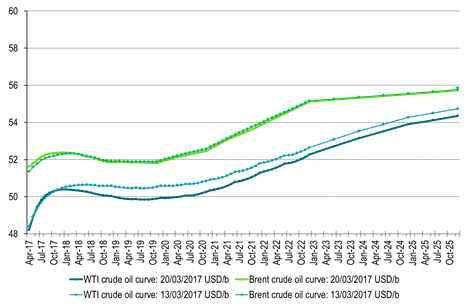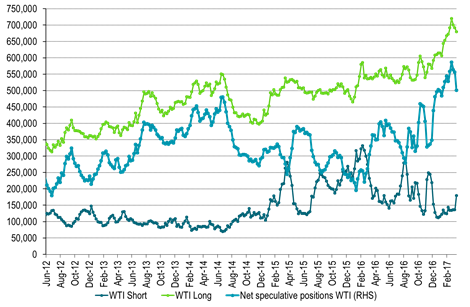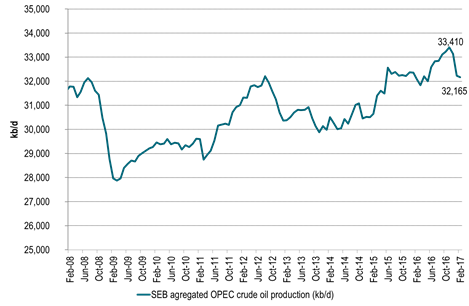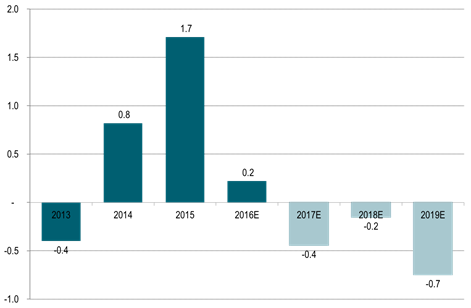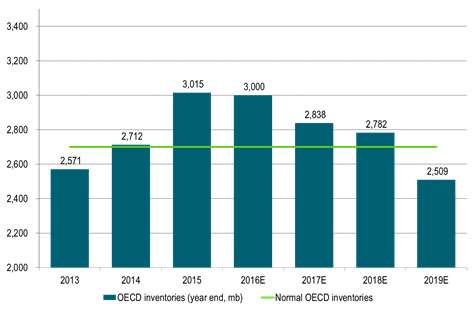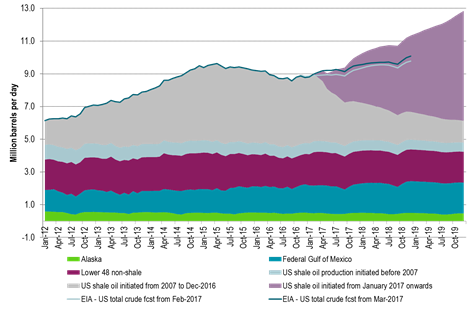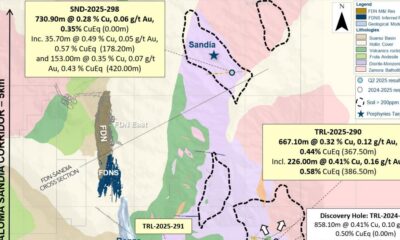Analys
US crude recovery could cover all OPEC cuts

 Over the last two weeks Brent crude has fallen close to $4/b. Market perception has shifted from “OPEC will do the job and US crude production will recover gradually” to instead “Can OPEC do the job? and US production is rebounding strongly”. The hypothesis that US crude oil production will only recover gradually and slowly as long as the oil price stays below $60/b has clearly fallen. The US EIA projects that US crude production will move above its April 2015 peak of 9.6 mb/d in February 2018. We think that this will happen already in October 2017. However, if we extrapolate the average weekly increase since the start of 2017 (+33.9 kb/d/week) we get that with a starting point of 9.1 mb/d on the 10th of March then US crude production will pass the 9.6 mb/d already in June 2017. Thus full attention to the US EIA’s weekly publishing of US crude production is clearly warranted.
Over the last two weeks Brent crude has fallen close to $4/b. Market perception has shifted from “OPEC will do the job and US crude production will recover gradually” to instead “Can OPEC do the job? and US production is rebounding strongly”. The hypothesis that US crude oil production will only recover gradually and slowly as long as the oil price stays below $60/b has clearly fallen. The US EIA projects that US crude production will move above its April 2015 peak of 9.6 mb/d in February 2018. We think that this will happen already in October 2017. However, if we extrapolate the average weekly increase since the start of 2017 (+33.9 kb/d/week) we get that with a starting point of 9.1 mb/d on the 10th of March then US crude production will pass the 9.6 mb/d already in June 2017. Thus full attention to the US EIA’s weekly publishing of US crude production is clearly warranted.
If US production had only recovered slowly as long as the oil price stayed below $60/b, then it would easily have been in OPEC’s power to drive the oil price rather quickly back to $60/b. However, US shale oil rig count rose by 7 rigs per week in H2-17 when the WTI 15mth forward price averaged around $52/b in H2-16. When that part of the forward curve was pushed up to $55-56/b following OPEC’s decision to cut it lifted the weekly rig count additions to 9.2 rigs/week on average so far in 2017. Along with the latest sell-off the WTI 15mths price has now fallen back to $50.5/b. This can be interpreted as an effort by the market to push back the current acceleration in shale oil investments. If this price stays at this level of about $50/b then we won’t know the effect of this before some 6-8 weeks down the road which is the typical lag between price action to rig count reaction. Thus the growth in US shale oil rig count is likely to continue unabated all through April.
OPEC will meet on the 25th of May this year to discuss whether to continue its cuts or not. US crude oil production stood at 8.7 mb/d when OPEC decided to cut at its 30th November meeting in 2016. That was only 0.25 mb/b above the US crude production trough of 8.45 mb/d in July/August 2016. The general view then was clearly that US crude production would recover gradually. There would not be much acceleration unless the oil price moved up to $60/b. OPEC decided to cut 1.16 mb/d from its October production level which lead to a production target of 31.8 mb/d for H1-17. So far OPEC has cut 0.4 mb/d less than planned with an averaged Jan/Feb production of 32.2 mb/d. I.e. the organisation has cut some 0.8 mb/d versus its October 2016 level. Back in November a US crude production rebound was not even on the horizon and not much discussed. The US EIA’s monthly report only stretched out to the end of 2017 with a prediction that US crude production would hit 8.94 mb/d in Dec 2017 which was just 250 kb/d above the US crude production in November 2016.
Now it all looks different. If we look away from EIA’s projection of US hitting 9.6 mb/d in Feb 2018 and instead focus on the latest weekly production data of 9.1 mb/d and extend it with the growth trend so far this year then US production would hit close to 9.5 mb/d just when OPEC’s members meet on the 25th of May. US production would then have increased by close to 0.8 mb/d since OPEC decided to cut in November 2016. That is close to exactly what OPEC has cut in Jan and Feb. Thus if OPEC’s compliance to the decided cuts don’t rise from here then US crude oil production recovery could end up rising equaly much as OPEC ended up cutting. The previous oil minister in Saudi Arabia, Ali al-Naimi’s words that an OPEC cut would only yield a lower market share while not necessarily lift the oil price may start to ring in the back of the head of OPEC’s members. We don’t expect OPEC to extend its cuts into H2-17. We have this itching feeling that OPEC compliance to cuts may start to erode towards the end of H1-17. Especially if the expectation is that there will be no further cuts.
Speculative market repositioning helped to shift oil prices lower
The pullback in the oil price last two weeks was clearly a repositioning in speculative positions as holders of long positions started to be concerned about the increasingly visible strong US production recovery. Net long speculative positions in WTI reached close to 600 mb some 4 weeks ago but have now sold off back down to 500 mb. A more neutral level is however around 350 mb. Thus there is still risk for further bearish repositioning.
We still expect Brent crude at $57.5/b in Q2-17 before falling back to $52.5/b in Q4-17
We are still positive for crude oil prices into Q2-17 where we expect front month Brent to average $57.5/b. We expect to see inventories to start to draw any moment as OPEC’s elevated production in Nov and Dec now increasingly is assimilated. Global refineries are also now increasingly coming back on line thus starting to process crude oil again. As oil inventories continues to draw as it did all through H2-16 we expect the forward crude oil curves to flip fully into backwardation. This will then enable the Brent crude oil front month contract to move up to $57.5/b while still leaving the WTI 15mth contract at around $51-52/b. Our outlook for Q2-17 is however at risk if US crude oil production continues to grow at its current trend rate. We still expect Brent crude to head down to average $52.5/b in Q4-17 in order to cool US shale oil production growth.
We expect OECD inventories to draw down 160 million barrels in 2017
The market was disappointed when it heard from IEA that OECD inventories rose by 48 mb in January. In perspective however, OECD inventories normally increase by some 30 mb from Dec to Jan. Thus the increase in inventories was only 18 mb more than normal. What is striking is that OECD’s inventories trended downwards all through H2-16 and ended down y/y for the first time in a long, long time in both December and January. And this was even without the help of OPEC cuts. We still expect the oil market to run a deficit of some 0.4 mb/d in 2017 thus resulting in a steady draw in inventories. Thus we have passed the OECD peak inventories and we are now heading downwards. The higher activation of US shale oil rigs than expected over the last two to three months has however impacted our projected supply/demand balance for 2018 leading to virtually no deficit in 2018 and thus very limited draws. Thus 2018 look likely to be a waiting year for the oil market with still plenty of oil in OECD inventories and with few pressure points.
Ch1: OECD down y/y for the first time in a long time in Dec and Jan
We are past the peak OECD inventories. To draw down from here
Ch2: Strong US production growth recovery is posing a problem for OPEC
OPEC cuts unlikely to continue in H2-17 as US production may reach 9.5 mb/d already in late May (trend extrapolation)
Ch3: Latest sell-off has increased the depth of front end crude curve contango
This contango and discount for spot crude prices versus longer dated contracts is just what OPEC wants to get away from
The 1-2 year forward WTI curve has shifted down to $50/b which would reduce the profitability for new shale oil investments
Ch4: Net long speculative WTI positions has pulled back but are still high
Now standing at 500,000 contracts or 500 million barrels.
Neutral level would be around 350 million barrels
Ch5: OPEC production at 32.16 mb/d in Feb and thus some 350 kb/d above its target.
Will OPEC compliance fall apart if it becomes increasingly clear that there will be no cuts in H2-17?
Ch6: We still expect a deficit the next three years despite strong US production growth
The balance assumes no OPEC cuts after H1-17
Ch7: Due to current high OECD inventories the global oil market is fine all through 2017 and 2018.
Not a lot of pressure points to be seen before 2019
Ch8: And yes, we are bullish US crude oil production but even more than that is needed in 2019
Then it all boils down to “too little too late” or “too much too soon”.
The US EIA is lifting its prognosis every month all since last July.
We expect them to continue to do that going forward as well as the EIA prognosis is still way behind the curve in our view.
Kind regards
Bjarne Schieldrop
Chief analyst, Commodities
SEB Markets
Merchant Banking
Analys
OPEC+ in a process of retaking market share

Oil prices are likely to fall for a fourth straight year as OPEC+ unwinds cuts and retakes market share. We expect Brent crude to average USD 55/b in Q4/25 before OPEC+ steps in to stabilise the market into 2026. Surplus, stock building, oil prices are under pressure with OPEC+ calling the shots as to how rough it wants to play it. We see natural gas prices following parity with oil (except for seasonality) until LNG surplus arrives in late 2026/early 2027.

Oil market: Q4/25 and 2026 will be all about how OPEC+ chooses to play it
OPEC+ is in a process of unwinding voluntary cuts by a sub-group of the members and taking back market share. But the process looks set to be different from 2014-16, as the group doesn’t look likely to blindly lift production to take back market share. The group has stated very explicitly that it can just as well cut production as increase it ahead. While the oil price is unlikely to drop as violently and lasting as in 2014-16, it will likely fall further before the group steps in with fresh cuts to stabilise the price. We expect Brent to fall to USD 55/b in Q4/25 before the group steps in with fresh cuts at the end of the year.

Natural gas market: Winter risk ahead, yet LNG balance to loosen from 2026
The global gas market entered 2025 in a fragile state of balance. European reliance on LNG remains high, with Russian pipeline flows limited to Turkey and Russian LNG constrained by sanctions. Planned NCS maintenance in late summer could trim exports by up to 1.3 TWh/day, pressuring EU storage ahead of winter. Meanwhile, NE Asia accounts for more than 50% of global LNG demand, with China alone nearing a 20% share (~80 mt in 2024). US shale gas production has likely peaked after reaching 104.8 bcf/d, even as LNG export capacity expands rapidly, tightening the US balance. Global supply additions are limited until late 2026, when major US, Qatari and Canadian projects are due to start up. Until then, we expect TTF to average EUR 38/MWh through 2025, before easing as the new supply wave likely arrives in late 2026 and then in 2027.
Analys
Manufacturing PMIs ticking higher lends support to both copper and oil

Price action contained withing USD 2/b last week. Likely muted today as well with US closed. The Brent November contract is the new front-month contract as of today. It traded in a range of USD 66.37-68.49/b and closed the week up a mere 0.4% at USD 67.48/b. US oil inventory data didn’t make much of an impact on the Brent price last week as it is totally normal for US crude stocks to decline 2.4 mb/d this time of year as data showed. This morning Brent is up a meager 0.5% to USD 67.8/b. It is US Labor day today with US markets closed. Today’s price action is likely going to be muted due to that.

Improving manufacturing readings. China’s manufacturing PMI for August came in at 49.4 versus 49.3 for July. A marginal improvement. The total PMI index ticked up to 50.5 from 50.2 with non-manufacturing also helping it higher. The HCOB Eurozone manufacturing PMI was a disastrous 45.1 last December, but has since then been on a one-way street upwards to its current 50.5 for August. The S&P US manufacturing index jumped to 53.3 in August which was the highest since 2022 (US ISM manufacturing tomorrow). India manufacturing PMI rose further and to 59.3 for August which is the highest since at least 2022.
Are we in for global manufacturing expansion? Would help to explain copper at 10k and resilient oil. JPMorgan global manufacturing index for August is due tomorrow. It was 49.7 in July and has been below the 50-line since February. Looking at the above it looks like a good chance for moving into positive territory for global manufacturing. A copper price of USD 9935/ton, sniffing at the 10k line could be a reflection of that. An oil price holding up fairly well at close to USD 68/b despite the fact that oil balances for Q4-25 and 2026 looks bloated could be another reflection that global manufacturing may be accelerating.
US manufacturing PMI by S&P rose to 53.3 in August. It was published on 21 August, so not at all newly released. But the US ISM manufacturing PMI is due tomorrow and has the potential to follow suite with a strong manufacturing reading.
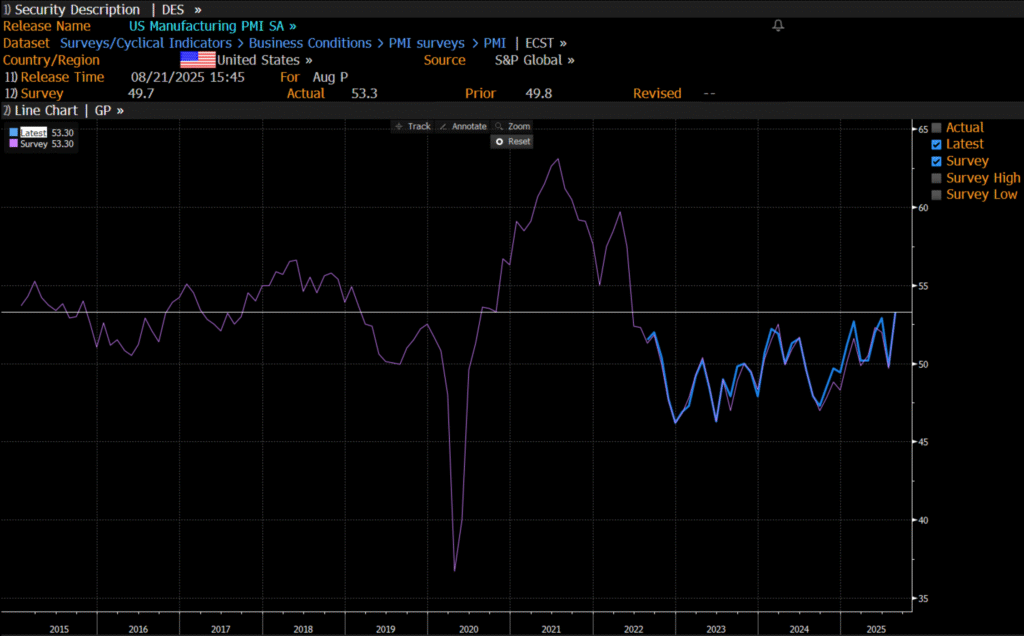
Analys
Crude stocks fall again – diesel tightness persists

U.S. commercial crude inventories posted another draw last week, falling by 2.4 million barrels to 418.3 million barrels, according to the latest DOE report. Inventories are now 6% below the five-year seasonal average, underlining a persistently tight supply picture as we move into the post-peak demand season.

While the draw was smaller than last week’s 6 million barrel decline, the trend remains consistent with seasonal patterns. Current inventories are still well below the 2015–2022 average of around 449 million barrels.
Gasoline inventories dropped by 1.2 million barrels and are now close to the five-year average. The breakdown showed a modest increase in finished gasoline offset by a decline in blending components – hinting at steady end-user demand.
Diesel inventories saw yet another sharp move, falling by 1.8 million barrels. Stocks are now 15% below the five-year average, pointing to sustained tightness in middle distillates. In fact, diesel remains the most undersupplied segment, with current inventory levels at the very low end of the historical range (see page 3 attached).
Total commercial petroleum inventories – including crude and products but excluding the SPR – fell by 4.4 million barrels on the week, bringing total inventories to approximately 1,259 million barrels. Despite rising refinery utilization at 94.6%, the broader inventory complex remains structurally tight.
On the demand side, the DOE’s ‘products supplied’ metric – a proxy for implied consumption – stayed strong. Total product demand averaged 21.2 million barrels per day over the last four weeks, up 2.5% YoY. Diesel and jet fuel were the standouts, up 7.7% and 1.7%, respectively, while gasoline demand softened slightly, down 1.1% YoY. The figures reflect a still-solid late-summer demand environment, particularly in industrial and freight-related sectors.


-

 Nyheter4 veckor sedan
Nyheter4 veckor sedanOmgående mångmiljardfiasko för Equinors satsning på Ørsted och vindkraft
-

 Nyheter2 veckor sedan
Nyheter2 veckor sedanMeta bygger ett AI-datacenter på 5 GW och 2,25 GW gaskraftverk
-

 Nyheter4 veckor sedan
Nyheter4 veckor sedanGuld stiger till över 3500 USD på osäkerhet i världen
-

 Analys4 veckor sedan
Analys4 veckor sedanWhat OPEC+ is doing, what it is saying and what we are hearing
-

 Nyheter2 veckor sedan
Nyheter2 veckor sedanAker BP gör ett av Norges största oljefynd på ett decennium, stärker resurserna i Yggdrasilområdet
-

 Nyheter4 veckor sedan
Nyheter4 veckor sedanLyten, tillverkare av litium-svavelbatterier, tar över Northvolts tillgångar i Sverige och Tyskland
-

 Analys3 veckor sedan
Analys3 veckor sedanBrent sideways on sanctions and peace talks
-

 Nyheter3 veckor sedan
Nyheter3 veckor sedanEtt samtal om koppar, kaffe och spannmål




